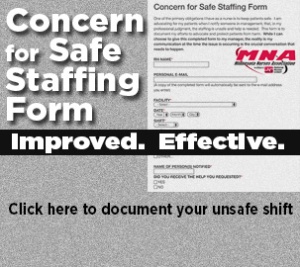It’s now much easier for Minnesota nurses to stand up for safe patient care.
Now when nurses submit submit Concern for Safe Staffing forms that document unsafe conditions in their facilities, they can also contact their legislators to let them know that unsafe staffing situations are occurring in their districts.
State senators and representatives have asked for more documentation to help them establish a safe patient standard in Minnesota hospitals.
In the past, CFSS forms have had to be culled, collected, and printed out to submit to legislative committees or for lawmaker requests. MNA recently modified the form to make it easier for nurses to tell their legislators real-time stories about unsafe staffing in their hospitals.
The revised form adds one simple step. After nurses complete a Concern for Safe Staffing form, they will receive a confirmation message with a link to a short pre-written email to their legislators to which they can add their own comments. The MNA website will automatically look up the nurses’ legislators and deliver the messages to them.
Some legislators have questioned whether staffing is a problem in Minnesota hospitals. When nurses show the forms to state legislators as examples of the unsafe conditions in hospitals in their districts, lawmakers are always surprised and concerned to learn hospitals put patients at risk on a regular basis.
The new option to contact legislators will increase the impact of CFSS forms by alerting lawmakers to the frequency and severity of these unsafe situations, and will further our campaign to pass a Safe Patient Standard law.
MNA members are encouraged to fill out CFSS forms any time they see unsafe staffing, and if you live in Minnesota, send the follow-up message to your legislators.
